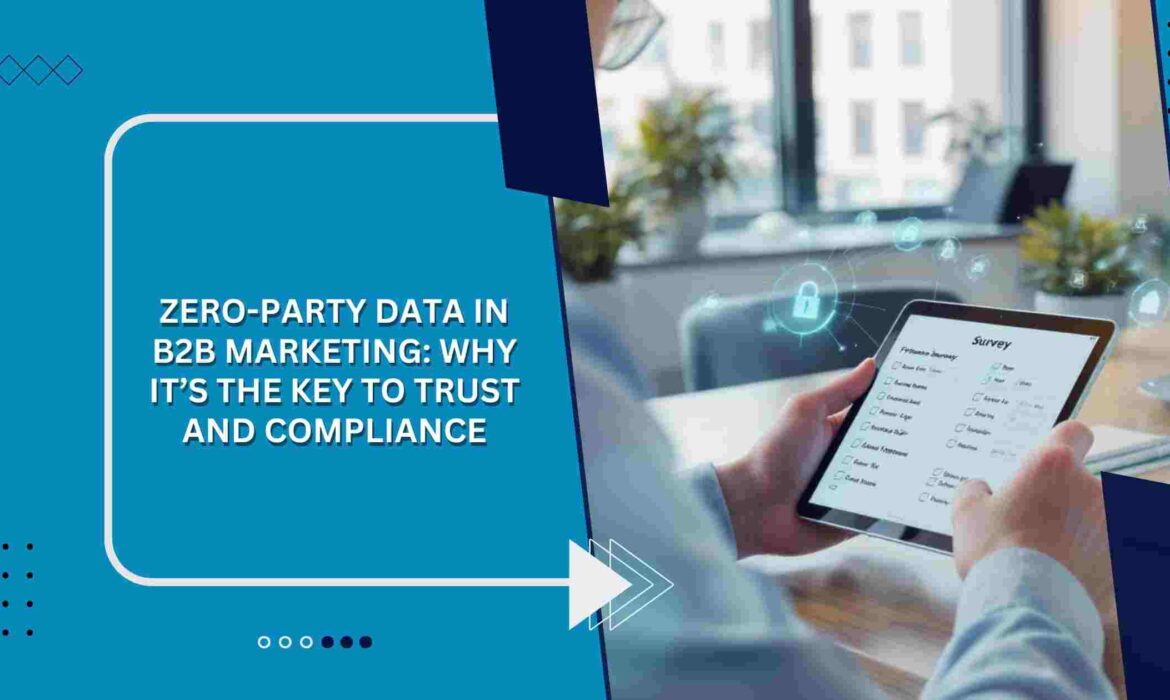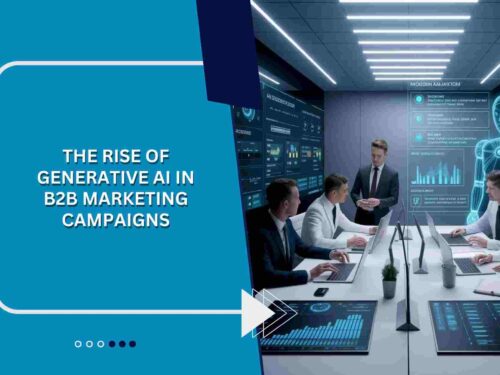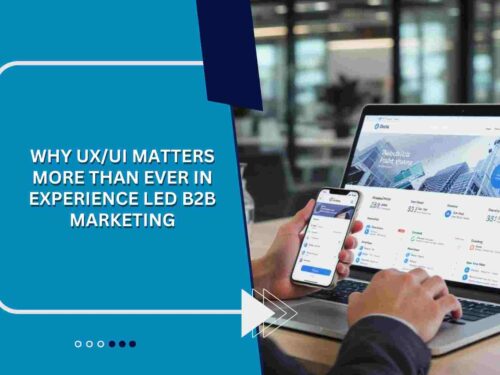In the world of modern B2B marketing, data has become the backbone of every strategy. From understanding buyer intent to delivering personalized campaigns, businesses depend on insights that allow them to connect with their audience more effectively. But as data privacy regulations tighten and buyers become more cautious, traditional data collection methods are losing credibility. That’s where Zero-Party Data comes into play a game-changer in how brands build trust while staying compliant.
What is Zero-Party Data in B2B Marketing?
Zero-Party Data is information that customers voluntarily and proactively share with businesses. Unlike first-party data, which is collected through tracking user behavior, or third-party data purchased from external sources, Zero-Party Data comes directly from the customer with full transparency.
In a B2B context, this could include:
- Preferences on communication frequency.
- Industry-specific pain points.
- Budget ranges and project timelines.
- Interests in product features or solutions.
- Feedback through surveys, polls, or interactive tools.
Since this data is freely given, it eliminates ambiguity and helps marketers avoid assumptions. Most importantly, it builds a foundation of trust and compliance, both of which are now critical for sustainable growth in B2B markets.
Why Zero-Party Data Matters More Than Ever
The rise of Zero-Party Data isn’t just another marketing buzzword it’s a response to real challenges that businesses face today:
- Data Privacy Regulations
With frameworks like GDPR, CCPA, and other global privacy laws, companies can no longer afford to rely on opaque tracking mechanisms or rented data sources. Zero-Party Data ensures compliance because customers willingly opt in and disclose information. - Buyer Expectations
Today’s B2B buyers expect personalized experiences similar to what they receive in the B2C world. Zero-Party Data allows marketers to understand decision-makers on a deeper level and deliver hyper-relevant campaigns without crossing privacy boundaries. - Decline of Third-Party Cookies
The phase-out of third-party cookies has forced organizations to rethink their data strategies. Zero-Party Data is a future-proof solution that empowers brands to continue personalizing without relying on third-party tracking.
The Role of Trust in B2B Marketing
Trust has always been a cornerstone of B2B relationships. A single deal often involves long sales cycles, high-value transactions, and multiple stakeholders. By leveraging Zero-Party Data, businesses create transparency in how they collect and use information.
When a prospect voluntarily shares their needs and pain points, it signals openness and willingness to engage. By respecting this data and using it responsibly, marketers can strengthen trust, shorten the sales cycle, and improve lead nurturing efforts.
How Zero-Party Data Enhances Compliance
Compliance isn’t just about avoiding penalties it’s about building a reputation for integrity. Zero-Party Data enhances compliance in the following ways:
- Explicit Consent: Since customers provide data willingly, businesses avoid gray areas related to consent.
- Data Accuracy: Because it comes directly from the source, Zero-Party Data reduces errors that often arise from assumptions or external databases.
- Reduced Risk: With less dependency on third-party vendors, companies minimize risks of data misuse or breaches.
In highly regulated industries such as healthcare, finance, or SaaS, this level of compliance is non-negotiable.
How to Collect Zero-Party Data in B2B Marketing
Collecting Zero-Party Data requires a balance between creativity and trust-building. Here are some effective strategies:
- Interactive Content
Quizzes, assessments, and surveys encourage users to share preferences in exchange for valuable insights. For example, a cloud solutions provider might offer an IT readiness assessment that asks buyers about their infrastructure challenges. - Preference Centers
Giving prospects the ability to set preferences for communication frequency, topics, and formats empowers them and provides marketers with rich Zero-Party Data. - Personalized Offers
By tailoring whitepapers, webinars, or demos based on user input, businesses create value-driven exchanges where users are more willing to share details. - Conversational Marketing
Tools like chatbots and AI-driven assistants can capture Zero-Party Data by asking contextual questions during interactions. - Surveys & Feedback Loops
Post-webinar surveys or customer satisfaction polls can uncover critical insights that guide future engagement strategies.
Turning Zero-Party Data into Marketing Value
Turning Zero-Party Data into marketing value goes far beyond simply collecting it it’s about applying it strategically to elevate B2B campaigns. By leveraging these insights, businesses can design hyper-personalized campaigns that segment audiences and deliver messaging aligned with their specific goals. Since the data is accurate and self-reported, sales teams can also improve lead scoring, allowing them to focus on the most promising prospects.
In addition, Zero-Party Data strengthens Account-Based Marketing by ensuring that outreach is highly precise and tailored to the right accounts with relevant value propositions. Ultimately, it also enhances the overall customer experience, enabling brands to provide personalized recommendations, targeted content, and meaningful offers that make the buyer’s journey smoother and more impactful.
Challenges of Zero-Party Data in B2B
While Zero-Party Data brings tremendous benefits to B2B marketing, it also presents unique challenges that businesses must navigate carefully. One of the primary hurdles is earning trust. Prospects are unlikely to share personal or business information unless they feel confident in the brand’s credibility and transparency. Organizations need to clearly communicate how the data will be used, ensure compliance with privacy standards, and demonstrate respect for customer preferences to establish that trust.
Another challenge lies in the value exchange. Buyers are willing to provide Zero-Party Data only when they perceive real benefits in return. This means businesses must consistently deliver meaningful resources such as personalized insights, valuable tools, or relevant content that make the exchange worthwhile. Without a strong value proposition, prospects may hesitate to engage.
Scalability is also a significant concern. Collecting Zero-Party Data across multiple channels, campaigns, and buyer touchpoints requires well-integrated systems, automation, and a clear strategy to manage the process effectively. Without these capabilities, the effort to scale data collection can become fragmented and inefficient.
Finally, consistency plays a crucial role in ensuring long-term success. Zero-Party Data collection should not be treated as a one-time initiative. Instead, it needs to be a continuous practice where insights are updated regularly to reflect the evolving needs, interests, and priorities of buyers. By keeping the data fresh and relevant, businesses can avoid stagnation and maintain meaningful engagement over time.
Future of Zero-Party Data in B2B Marketing
Looking ahead, Zero-Party Data will become the backbone of every successful B2B strategy. As personalization, AI, and automation evolve, this data will fuel smarter campaigns and stronger buyer engagement.
Emerging trends include:
- AI-Powered Personalization: AI tools will analyze Zero-Party Data to create dynamic and adaptive marketing experiences.
- Predictive Engagement: Zero-Party Data will help predict buying intent and trigger timely interventions.
- Integration with CRM & CDP: Businesses will seamlessly merge Zero-Party Data into customer data platforms for unified insights.
The future belongs to companies that prioritize transparency, respect customer privacy, and deliver value in exchange for data.
If you want to build trust, stay compliant, and deliver hyper-personalized experiences, adopting a Zero-Party Data strategy with Acceligize is no longer optional it’s essential. Start transforming your campaigns today with expert guidance.




